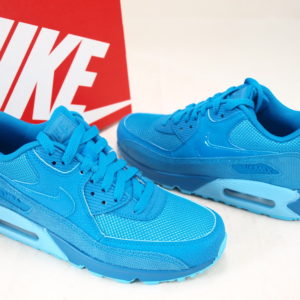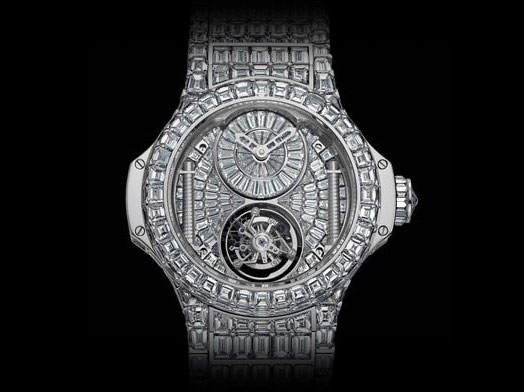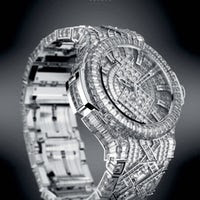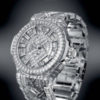Subtotal: $160.00
It’s been said that nothing exceeds like excess, and Hublot’s unique diamond-crusted Big Bang watch certainly fits the bill. The company claims that the watch is the most “precious” timepiece it’s ever created in its 32-year history (Hublot, which means porthole in French, was founded by Carlo Crocco in 1980). Indeed, if there’s a more expensive watch in existence, we have yet to see it.
So just what goes into a US$5 million watch? For starters, the 1.73-inch (44-mm) diameter 18K white gold case is packed with 302 baguette diamonds. Its 18K white gold dial holds another 179 baguettes and the 18K bracelet that holds it on the lucky owner’s wrist is set with a staggering 782 morebaguette diamonds, plus an additional six emerald-cut diamonds, all greater than 3 carats each. Throw in the 18K white gold crown’s 1.06 carat rose-cut diamond, plus its 12 additional baguettes and you have a market-cornering 1,282 diamonds in total, more than 100 carats in baguettes alone, and all of grade A VVS clarity.
The rhodium-plated, diamond-polished hands are driven by a self-winding, 25-jewel, HUB 1100 movement with about 42 hours of power reserve. Nice, but for five mill, would installing a battery have been too much to ask? Perhaps. In some circles, battery-powered watches are considered just another piece of jewelry, not fine timepieces.
Also, let’s not forget the cost of labor, which was particularly intense because each carefully-selected jewel had to be modified to perfectly fit the watch. After a year spent searching for the largest stones, Hublot, in collaboration with Geneva’s Atelier Bunter, spent 14 months total on the Big Bang’s construction. This included the efforts of 12 cutters and five setters who worked on it full-time for seven months!

 Nike Womens Air Max 1 Premium Sneaker Light Blue
Nike Womens Air Max 1 Premium Sneaker Light Blue 








